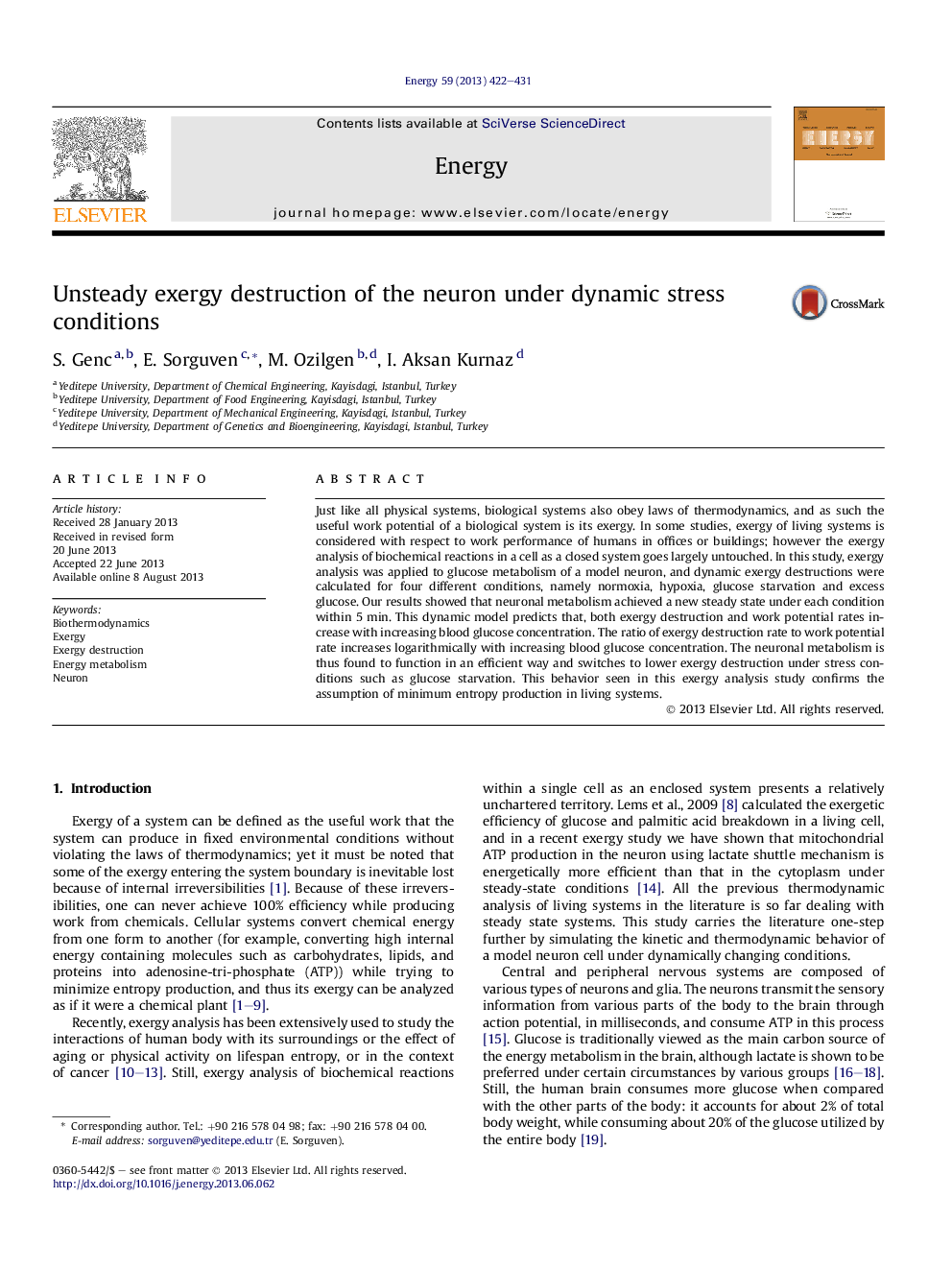| کد مقاله | کد نشریه | سال انتشار | مقاله انگلیسی | نسخه تمام متن |
|---|---|---|---|---|
| 8079220 | 1521487 | 2013 | 10 صفحه PDF | دانلود رایگان |
عنوان انگلیسی مقاله ISI
Unsteady exergy destruction of the neuron under dynamic stress conditions
ترجمه فارسی عنوان
نابودی بیرونی اضافی از نورون در شرایط تنش دینامیکی
دانلود مقاله + سفارش ترجمه
دانلود مقاله ISI انگلیسی
رایگان برای ایرانیان
کلمات کلیدی
بیوترودینامیک، اگزرژی، تخریب اگزرژی، متابولیسم انرژی، نورون
ترجمه چکیده
درست مثل تمام سیستم های فیزیکی، سیستم های بیولوژیکی نیز از قوانین ترمودینامیک اطاعت می کنند، و به همین ترتیب پتانسیل کار مفید سیستم بیولوژیکی، اگزرژی آن است. در بعضی از مطالعات، اگزرژی سیستم های زندگی با توجه به عملکرد کار انسان در دفاتر و ساختمان ها در نظر گرفته می شود؛ با این حال، تجزیه و تحلیل اگزرژی واکنش های بیوشیمیایی در یک سلول به عنوان یک سیستم بسته، عمدتا به دست می آید. در این مطالعه، تجزیه و تحلیل اگزرژی به متابولیسم گلوکز یک مدل نورون اعمال شد و تخریب اگزرژی دینامیکی برای چهار شرایط مختلف، از جمله نوروموسیا، هیپوکسیا، گلودرد گلوکز و اضافه گلوکز محاسبه شد. نتایج ما نشان داد که متابولیسم عضلانی در هر شرایطی طی 5 تا 10 دقیقه یک حالت پایدار جدید به دست می آورد. این مدل پویای پیش بینی می کند که هر دو تخریب اگزرژی و نرخ بالقوه کار با افزایش غلظت گلوکز خون افزایش می یابد. نسبت میزان تخریب اگزرژی به میزان پتانسیل کار با افزایش غلظت گلوکز خون به صورت لگاریتمی افزایش می یابد. به این ترتیب متابولیسم عصبی به صورت کارآمد عمل می کند و به کاهش تخریب اگزرژی در شرایط تنش مانند گلوکز می انجامد. این رفتار که در این مطالعه تجزیه و تحلیل اگزرژ دیده می شود، فرضیه تولید حداقل آنتروپی در سیستم های زنده را تایید می کند.
موضوعات مرتبط
مهندسی و علوم پایه
مهندسی انرژی
انرژی (عمومی)
چکیده انگلیسی
Just like all physical systems, biological systems also obey laws of thermodynamics, and as such the useful work potential of a biological system is its exergy. In some studies, exergy of living systems is considered with respect to work performance of humans in offices or buildings; however the exergy analysis of biochemical reactions in a cell as a closed system goes largely untouched. In this study, exergy analysis was applied to glucose metabolism of a model neuron, and dynamic exergy destructions were calculated for four different conditions, namely normoxia, hypoxia, glucose starvation and excess glucose. Our results showed that neuronal metabolism achieved a new steady state under each condition within 5Â min. This dynamic model predicts that, both exergy destruction and work potential rates increase with increasing blood glucose concentration. The ratio of exergy destruction rate to work potential rate increases logarithmically with increasing blood glucose concentration. The neuronal metabolism is thus found to function in an efficient way and switches to lower exergy destruction under stress conditions such as glucose starvation. This behavior seen in this exergy analysis study confirms the assumption of minimum entropy production in living systems.
ناشر
Database: Elsevier - ScienceDirect (ساینس دایرکت)
Journal: Energy - Volume 59, 15 September 2013, Pages 422-431
Journal: Energy - Volume 59, 15 September 2013, Pages 422-431
نویسندگان
S. Genc, E. Sorguven, M. Ozilgen, I. Aksan Kurnaz,
